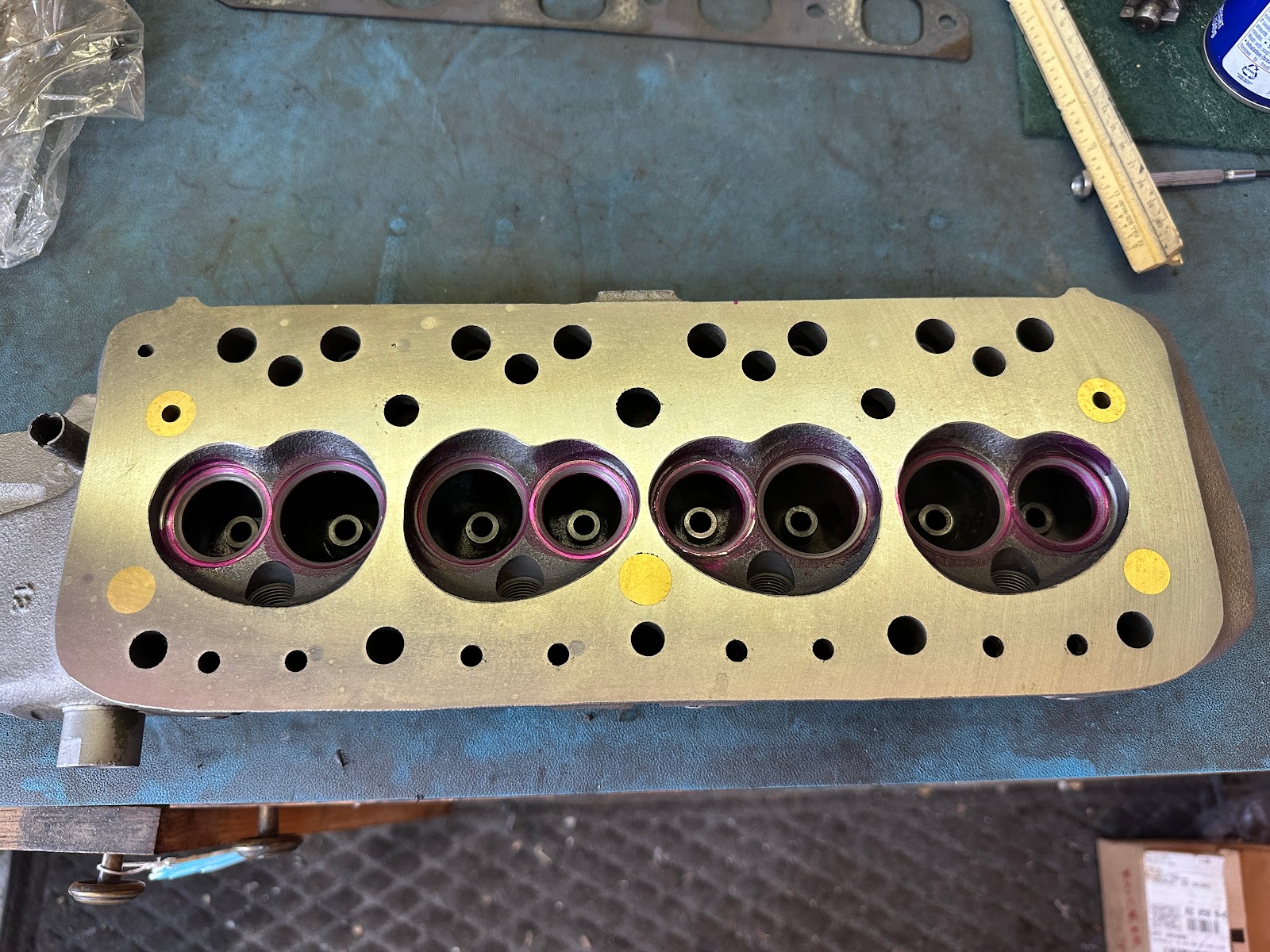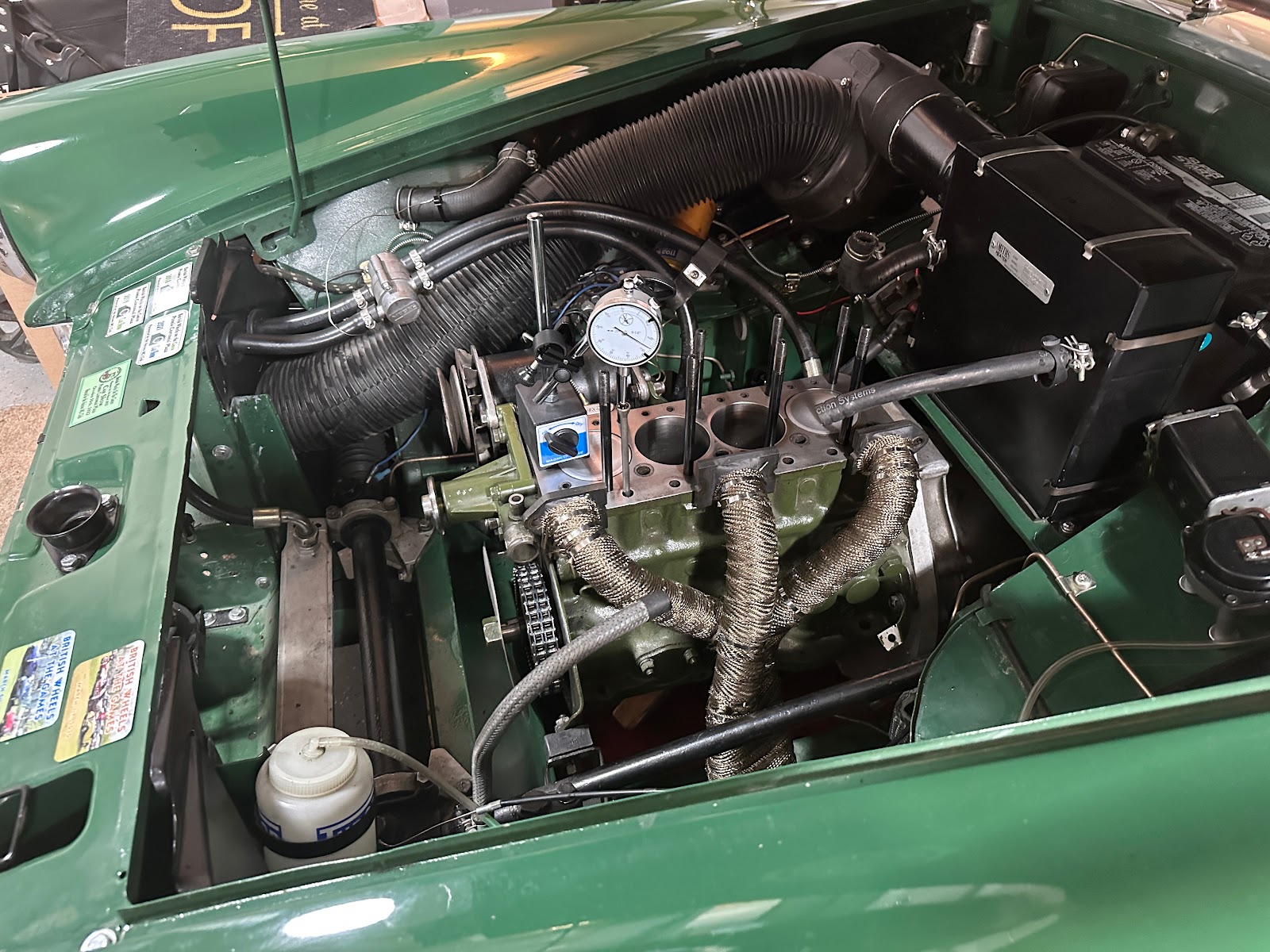I've been hearing some 'ticking' noises from Gidget's powerplant for a while, and so I stopped driving her regularly last fall after the 2023 BWOG. In fact, I've only driven her about 200 miles since then. I decided that today was the day I'd get around to doing something about it.
I figured the noise was coming from something related to the head, as that's where I was hearing it the most. It sounded like your regular old valve train noise, but only with one cylinder a bit louder. I checked valve lash and it was fine, so I figured something was up.
So I pulled the head. I knew the valve guides were iffy and the valve seats were not hardened, and I wanted that fixed anyhow. That went well. I'm going to do some porting work a la David Vizard, so I took it apart. And I got new tools.


I won't do anything radical; just a little cleanup work at the exhaust ports and some smoothing of the combustion chamber. But it looks so much better and the new iron (old-school!) guides are in place.
While I was waiting, I said to myself, "Self... this is a great time to do a couple of other things." I had wanted a new, more aggressive camshaft profile for a while now and I also wanted to look inside the oil pan to see why my oil pressure might be wonky at startup. When she starts, she doesn't hold "prime" and has to turn over a few too many times to build pressure, which is then not consistent until she warms up. That's not right.
So I got started. First things first - I removed the grille, so I could remove the radiator. It was an easy job. Too easy... as I would be paid back for later.
(This will also be an excellent opportunity to clean up the engine bay.)
After removing the fan and pulley from the water pump, I discovered a major problem. How was I going to get that pulley off the crankshaft?
There is a crossmember that supports the steering rack, and there is practically no clearance for the pulley to maneuvered out. I pondered this for a while, and decided that I could lift the engine on a jack if I removed the motor mount bolts. Again, this was a too-easy job and they came out in minutes. I lifted the engine up, and found I could not raise it enough to get the pulley to clear. I have a Datsun 5-speed conversion kit installed, and the bellhousing does not clear the heater tray.
See what I mean? It was too easy. Now I would pay.
I sat and stared at this problem for a good half hour, trying to figure out how I'd get an inch of clearance to be able to pull that pulley off. Well, at least I could get to the nut, once I moved the oil cooler out of the way enough to get an impact wrench in there. (The nut is 1 5/16", and I have one of those sockets). With a coupler, I had clearance, Clarence. The nut came off easily, but not too easily as one would expect.
At that point, I was well and truly stuck. In desperation, I thought I could perhaps remove the transmission mount and slide the engine back somewhat. The bad news there was twofold: 1) The mount is bolted to the transmission in places I cannot reach, and 2) even if I did so, I'd only get 1/2 of clearance. Being out of options, I decided to unbolt the mount from the body and slide the whole thing back that 1/2".
But happy times were ahead. I lifted the engine up again as far as I could, and tried to remove the pulley... and it came out!
Holy... um, something, Batman!
Now, I was in business. I removed the timing cover to see my beautiful new gears and chain.
To remove the camshaft, the chain and gears have to come out. In order to gain leverage I needed to stop the crankshaft from turning, so off came the oil pan and a piece of wood went in to a suitable spot. And that's when I noticed something else.
If you look in the upper section of the photo, you will see where the oil pickup tube connects to the block. You will also see that the nut that holds the pickup tube in place is completely unsecured. No wonder I had wonky oil pressure! The seal is a simple brass compression fitting, and without it being tightly held in place it will not be able to provide sufficient suction, and it won't hold a vacuum when the engine shuts down (aka the "prime" that keeps oil in the system ready to be pumped).
Score one for Team Me! Believe it or not, that was a welcome sight. It meant that my oil pump was not a source of failure. That wasn't coming out without pulling everything out and apart, and I really, really didn't want to do that.
Getting back to the main point of this story... I was able to pull the gears and timing chain pretty easily, as one would hope. (The camshaft nut is also a 1 5/16" socket. Good thing I had another one.)
Before I went any farther, I pulled the distributor so I could pull the distributor drive, which is driven by the camshaft.
By the way, you might notice a switch where there shouldn't be one. I installed a spin-on oil filter adapter, and so I no longer had a use for the light that comes on to indicate when the filter is clogged and being bypassed. I converted it to a low oil pressure light. It comes on when oil pressure is below 20psi, which is why I suspected something more than just the gauge for my wonky oil pressure problem.
I had reached the camshaft retaining plate. It was time to employ a trick I learned online.
The problem with replacing a camshaft in an A-Series 1275 engine is that there are no side covers to gain access to the tappets (cam followers / lifters). You are supposed to pull the engine, flip it over and do it the hard way. But I read about some magicks that would let me do the job in situ. The trick is to lift the tappets up and away from the cam lobes. The tappets are made of metal. Magnets stick to metal! So I bought some 5mm neodymium magnets for a few bucks, and got some pot stickers out of the kitchen drawer. I first superglued, then epoxied the magnets to the end of the sticks. I now had a set of 8 remote tappet puller-uppers!
I took one, inserted it in the pushrod hole and lifted gently. The tappet came up! In fact, all 8 of them did. I pulled them up and taped the sticks to the head studs, and the tappets were held out of the way. Removing the sticks is easy - I just pull a bit harder and they (and the magnets) come right out.
With the tappets no longer an issue, I removed the camshaft retaining plate. It was time for the big bravery test. I said a short prayer to the gods of English motoring, and ever so gently removed the camshaft. I needn't have worried - the cam came out easily and without fouling on the tappets.
I was elated. I couldn't believe that worked so well! I had to take a look underneath. I almost wish I hadn't.
If you look at the tappets, they are held right where I wanted them. But if you look at #6 (third from the right), you will see a horrible thing. The tappet surface is completely destroyed.
That explains the tapping noise. It sounds like valve #6 was sticking open a little long, causing the cam lobe to slam into the tappet and chew it up. The lobe isn't in any better shape.
This cam is toast.
Well, I bought a camshaft, so I suppose I am happy that I have a real need to install it. I have new tappets on order as well, but now I have to wait again. I don't know why I didn't order them with the cam - you ALWAYS replace tappets with a new cam. I guess I thought that such low miles on some fancy new tappets wouldn't have been a problem. I thought wrong.
Here's the camshaft I bought. It is an Evolution 001 from Mini Spares. The specs look good, and the price was right. It's cut from a new billet-steel blank and it's perfect.
I also bought forged Cooper S style rockers to match, as this cam doesn't work well with the 1.5 high lift rockers I have. I had also bought a new shaft and had the original pedestals (heck, I've got a bag full) so that went together lickety-split.
So stay tuned for the next episode, when I put all of this back together!




















































